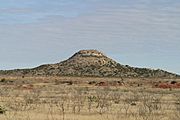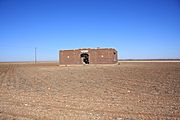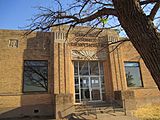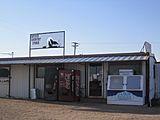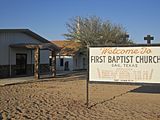Borden County, Texas facts for kids
Quick facts for kids
Borden County
|
|
|---|---|
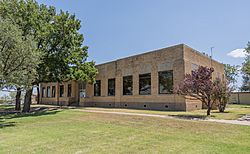
Borden County Courthouse in Gail
|
|
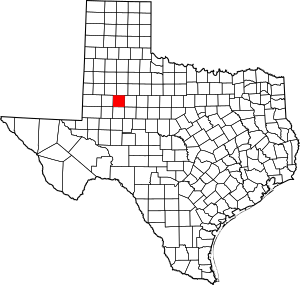
Location within the U.S. state of Texas
|
|
 Texas's location within the U.S. |
|
| Country | |
| State | |
| Founded | 1876 |
| Named for | Gail Borden Jr. |
| Seat | Gail |
| Largest community | Gail |
| Area | |
| • Total | 906 sq mi (2,350 km2) |
| • Land | 897 sq mi (2,320 km2) |
| • Water | 8.6 sq mi (22 km2) 1.0% |
| Population
(2020)
|
|
| • Total | 631 |
| • Estimate
(2022)
|
585 |
| • Density | 0.6965/sq mi (0.2689/km2) |
| Time zone | UTC−6 (Central) |
| • Summer (DST) | UTC−5 (CDT) |
| Congressional district | 19th |
Borden County is a rural county located in the U.S. state of Texas. It is in West Texas and its county seat is Gail.
As of the 2020 census, its population was 631, making it the fifth-least populous county in Texas. Borden is one of four remaining prohibition or entirely dry counties in the state of Texas.
The county was created in 1876 and later organized in 1891. Gail and Borden County are named for Gail Borden Jr., businessman, publisher, surveyor, and pioneer of condensed milk.
Contents
History
Native Americans
Shoshone and the Penateka band of Comanches were early tribes in the area.
County established
Borden County was created in 1876 from Bosque County and named for Gail Borden Jr., the inventor of condensed milk. Borden was publisher and editor of the Telegraph and Texas Register, as well as a political leader in the Republic of Texas. The county was organized in 1891, and Gail was made the county seat.
Farmers and ranchers settled the county, but the population remained relatively small. In 1902, Texas placed lands in the public domain and spurred a land rush in Borden County. Many of the newcomers grew cotton.
Borden County has had two courthouses, one built in 1890. The current courthouse is of brick and concrete construction and was erected in 1939. The architect was David S. Castle Co.
Oil was discovered in the county in 1949. By 1991, more than 340,000,000 barrels (54,000,000 m3) of petroleum had been taken out of Borden County since its discovery.
Geography
According to the United States Census Bureau, the county has a total area of 906 square miles (2,350 km2), of which 897 square miles (2,320 km2) are land and 8.6 square miles (22 km2) (1.0%) are covered by water.
Major highways
Adjacent counties
- Garza County (north)
- Scurry County (east)
- Mitchell County (southeast)
- Howard County (south)
- Martin County (southwest)
- Dawson County (west)
- Lynn County (northwest)
Demographics
| Historical population | |||
|---|---|---|---|
| Census | Pop. | %± | |
| 1880 | 35 | — | |
| 1890 | 222 | 534.3% | |
| 1900 | 776 | 249.5% | |
| 1910 | 1,386 | 78.6% | |
| 1920 | 965 | −30.4% | |
| 1930 | 1,505 | 56.0% | |
| 1940 | 1,396 | −7.2% | |
| 1950 | 1,106 | −20.8% | |
| 1960 | 1,076 | −2.7% | |
| 1970 | 888 | −17.5% | |
| 1980 | 859 | −3.3% | |
| 1990 | 799 | −7.0% | |
| 2000 | 729 | −8.8% | |
| 2010 | 641 | −12.1% | |
| 2020 | 631 | −1.6% | |
| 2022 (est.) | 585 | −8.7% | |
| U.S. Decennial Census 1850–2010 2010-2020 |
|||
| Race / Ethnicity (NH = Non-Hispanic) | Pop 2000 | Pop 2010 | Pop 2020 | % 2000 | % 2010 | % 2020 |
|---|---|---|---|---|---|---|
| White alone (NH) | 624 | 539 | 528 | 85.60% | 84.09% | 83.68% |
| Black or African American alone (NH) | 1 | 0 | 1 | 0.14% | 0.00% | 0.16% |
| Native American or Alaska Native alone (NH) | 2 | 2 | 0 | 0.27% | 0.31% | 0.00% |
| Asian alone (NH) | 0 | 1 | 0 | 0.00% | 0.16% | 0.00% |
| Pacific Islander alone (NH) | 0 | 0 | 0 | 0.00% | 0.00% | 0.00% |
| Other race alone (NH) | 0 | 0 | 1 | 0.00% | 0.00% | 0.16% |
| Mixed race or Multiracial (NH) | 15 | 4 | 15 | 2.06% | 0.62% | 2.38% |
| Hispanic or Latino (any race) | 87 | 95 | 86 | 11.93% | 14.82% | 13.63% |
| Total | 729 | 641 | 631 | 100.00% | 100.00% | 100.00% |
As of the census of 2000, 729 people, 292 households, and 216 families resided in the county. The population density was 0.80 people per square mile (0.31 people/km2). The 435 housing units averaged 0.48 units per square mile (0.19/km2). The racial makeup of the county was 90.53% White, 0.14% African American, 0.27% Native American, 6.31% from other races, and 2.74% from two or more races. About 11.93% of the population was Hispanic or Latino of any race.
Of the 292 households, 30.10% had children under the age of 18 living with them, 65.10% were married couples living together, 6.20% had a female householder with no husband present, and 25.70% were not families. Around 22.60% of all households consisted of individuals, and 9.20% had someone living alone who was 65 years of age or older. The average household size was 2.50 and the average family size was 2.93.
In the county, the population was distributed as 24.60% under the age of 18, 6.70% from 18 to 24, 27.40% from 25 to 44, 25.00% from 45 to 64, and 16.30% who were 65 years of age or older. The median age was 40 years. For every 100 females, there were 103.10 males. For every 100 females age 18 and over, there were 108.30 males.
The median income for a household in the county was $29,205, and for a family was $36,458. Males had a median income of $25,556 versus $21,607 for females. The per capita income for the county was $18,364. About 14.00% of the population and 11.80% of families were below the poverty line. Of the total people living in poverty, 14.30% were under the age of 18 and 11.60% were 65 or older.
The county is served by nearby radio stations KBXJ (FM) and KPET (AM), and the various Midland and Odessa radio and TV stations.
The largest self-reported ancestry groups in Borden County are: · English – 17% · Irish – 15% · German – 12% · Mexican – 9% · French (except Basque) – 3% · Scotch-Irish – 3% · Other Hispanic or Latino – 3% · Scottish – 2% · Spanish – 1% · American Indian tribes, specified – 1%
Education
The county is served mostly by Borden County Independent School District, with remaining portions in the Sands Consolidated Independent School District.
The Texas Legislature designated the county as being in the Western Texas College District.
Media
The weekly newspaper, the Borden Star, covers events for the school and county.
Communities
Gallery
-
Mushaway Peak viewed from Willow Valley Road
-
Abandoned schoolhouse in the ghost town of Mesquite
See also
 In Spanish: Condado de Borden para niños
In Spanish: Condado de Borden para niños


